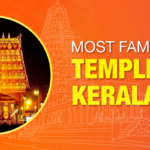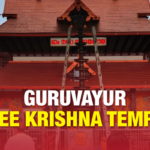The Thrissur Pooram is a renowned Hindu temple festival that takes place annually in Thrissur, Kerala, India. Celebrated at the Vadakkunnathan Temple, it occurs on the day of Pooram, which coincides with the rising of the Pooram star in the Malayalam Calendar month of Medam. This festival holds the distinction of being the largest and most famous pooram in India, and it attracts over one million visitors, making it one of the largest festivals in Asia.
Thrissur Pooram History
The festival of Thrissur Pooram was introduced by Rama Varma Kunhjippilla Thampuran, popularly known as Sakthan Thampuran, the Cochin Maharaja. Previously, the largest temple festival in Kerala was the one-day event called Arattupuzha Pooram held in Aarattupuzha. Temples from the vicinity of Thrissur used to participate in this festival. However, in 1798, due to continuous rainfall, the temples from Thrissur arrived late for the Arattupuzha Pooram and were not allowed to take part in the procession. This incident led to embarrassment and anger among the temple authorities, who then approached Sakthan Thampuran to address the issue.
In response, Sakthan Thampuran decided to unite the ten temples located around the Vadakkunnathan Temple and organize the grand celebration of Thrissur Pooram as a collective festival. He extended invitations to temples with their respective deities to come to Thrissur and pay homage to Lord Vadakkunnathan, the presiding deity of the Vadakkunnathan Temple. One distinctive feature of this festival is that all the items used in the festivities, such as umbrellas and nettipattam (ornamental headdress), are meticulously crafted anew each year. Skilled artisans are assigned the task of creating these items from scratch for the occasion.
Thrissur Pooram Festival Details
The Thrissur Pooram is a magnificent festival that combines the spiritual and cultural essence of Kerala, characterized by a splendid display of caparisoned elephants, dazzling parasols, and percussion music. Celebrated annually in the month of medam (April-May), this grand event takes place at Thekkinkadu Maidanam in Thrissur.
Regarded as the epitome of all poorams, this temple festival was conceived by Shakthan Thampuran, the Maharaja of Kochi, who organized the participation of ten temples including Paramekkavu, Thiruvambadi Kanimangalam, Karamucku, Laloor, Choorakottukara, Panamukkampally, Ayyanthole, Chembukkavu, and Neythilakavu.
The festival showcases a captivating procession of beautifully adorned elephants and features the kudamattom ceremony as a highlight. During this ceremony, the brightly colored and sequined parasols are swiftly and rhythmically changed, captivating the audience’s attention.
Another enchanting aspect is the ilanjithara melam, a mesmerizing performance by traditional musicians that elevates the spirits of the thousands in attendance. Approximately 250 artists participate in this traditional orchestra, led by chenda players, and the spectators enthusiastically wave their hands to the rhythm created by the chenda, kurumkuzhal, kombu, and elathalam—traditional instruments of Kerala. The festival culminates with a spectacular fireworks display, adding to the grandeur of the event.
Thrissur Pooram Flag Hoisting Ceremony
The commencement of the Thrissur Pooram is marked by the official flag-hoisting ceremony. Known as Kodiyettam, the flag hoisting ceremony takes place seven days prior to the Thrissur Pooram. During this event, all the participating temples of the festival gather together, and a ceremonial flag is raised. To signify the start of the grand celebration, a light fireworks display illuminates the sky.
Main Thrissur Pooram
The Thrissur Pooram kicks off with the early morning procession of Kanimangalam Sastha, followed by six other temple processions. A highlight of the festival is the splendid “Madathil varavu,” featuring over 200 artists playing traditional instruments such as thimila, madhalam, trumpet, cymbal, and edakka. Inside the Vadakkunnathan Temple, the enchanting Ilanjithara melam takes center stage with its captivating combination of drums, trumpets, pipes, and cymbals. Adding to the grandeur are the more than 50 beautifully adorned elephants adorned with nettipattam, Kolam designs, decorative bells, and ornaments.
As the Thrissur Pooram nears its conclusion, the Paramekkavu and Thiruvambadi groups enter the temple, exit through different gates, and face each other in a distant location. The mesmerizing Kudamattom spectacle unfolds as they compete, exchanging vibrant umbrellas atop the elephants. Finally, the grand finale takes place at Nilapaduthara, near the western gopuram of the Vadakkunnathan Temple.
An outstanding aspect of the Thrissur Pooram is its inclusive nature, where all religious communities actively participate and play significant roles. The festival showcases the harmonious relationship among different faiths, with the Muslim community contributing to the pandal works and the churches and their members providing materials for the Kudamattom umbrellas. This long-standing interfaith unity is a source of immense pride for the people of Kerala.
Thrissur Pooram Main Firework Ritual
The fireworks display during the Thrissur Pooram is renowned nationwide and takes place at the heart of Thrissur city, in Thekkinkadu Maidan. Thiruvambadi and Paramekkavu are the main participants in this captivating event. The fireworks commence in the early morning of the seventh day, attracting enthusiastic spectators who stay up all night to witness the spectacle. Visitors from distant locations come specifically to marvel at the breathtaking pyrotechnics.
The Thrissur Pooram showcases four significant fireworks displays that contribute to its grandeur. It begins with the “sample fireworks” held a day before the Pooram, followed by the mesmerizing sparklers lighting up the sky (amittu) on the Pooram evening after the Southward Descent. The highlight of the festival takes place in the early morning hours, symbolizing the pinnacle of the Pooram celebrations. Lastly, the seventh day concludes the event with the majestic farewell ceremony known as “Pakal Pooram.” During this ceremony, the idols from Thiruvambadi Sri Krishna Temple and Paramekkavu Bagavathi Temple are taken back to their respective temples, accompanied by the dazzling Pakal Vedikkettu fireworks, signifying the end of the Pooram.
The final event, Upacharam Cholli Piriyal (farewell ceremony), holds great significance not just as a festival but also as a time for hospitality among the people of Thrissur. Taking place at Swaraj Round, it serves as a remarkable conclusion to the Pooram celebrations, characterized by a sense of reverence and gratitude. The festival reaches its pinnacle with the enchanting spectacle of fireworks known as Pakal Vedikkettu.
Frequently Asked Questions – FAQs
When and where does the Thrissur Pooram festival take place?
Who introduced the Thrissur Pooram festival, and why?
What are some of the key features of the Thrissur Pooram festival?
How does the Thrissur Pooram showcase religious unity?
What are the significant fireworks displays during the Thrissur Pooram?
Stay tuned to Tiny Trip for more festival articles



